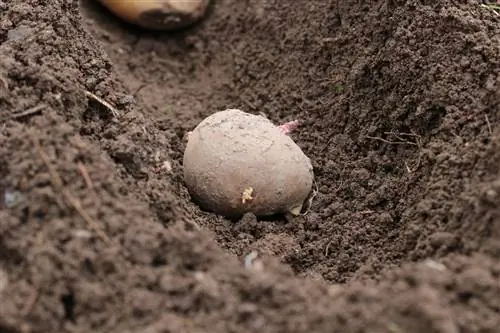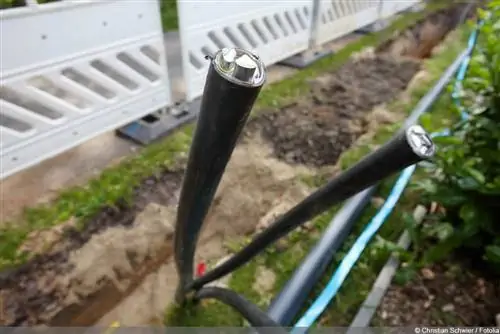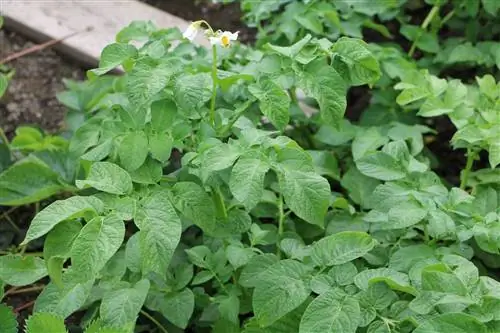- Author admin [email protected].
- Public 2023-12-17 03:39.
- Last modified 2025-01-24 12:45.
The correct spacing of the laying potatoes is just as important for the yield as a well-prepared bed and a good supply of nutrients. This article provides information about the correct distance and depth of the potatoes.
Laying depth
How deep potatoes are planted does not play such a big role compared to the planting distance in the row and between the rows. Some cultivation methods completely eliminate the need to dig a planting furrow. In contrast, potatoes are grown in ditches rather than in ridges. Usual furrows are around 5 to 10 cm deep, which is completely sufficient for potatoes.
Row spacing
In the dam culture, potatoes are piled up. For this, appropriate space must be planned between the rows. For new potatoes this is around 50 cm. It's better to have a little more than too little so that good dams can be built several times. These increase the harvest by forming new tubers on the shoots and prevent the potatoes from greening. The ridges are simply leveled during harvesting, hardly any potatoes need to be dug up.
New potatoes
Since the cultivation period for early potato varieties is comparatively short, the distance between them is also different than for storage potatoes. New potatoes are usually pre-germinated before being planted. The first germs and shoots and, with a bit of luck, roots will begin to form.
Note:
The yield of early potatoes should be increased if layer potatoes with many shoots are spaced further apart than potatoes with few shoots.
A simple rule is to place potatoes in rows with one foot between them. The average is 30 to 40 cm. However, putting your foot between the potatoes makes it easier to keep your distance.
Storage potatoes (late varieties)
Late varieties are not only planted and harvested later, they also have a significantly longer cultivation time, which means that they have to be piled up more often. A row spacing of 75 cm makes sense for this work. The spacing in the row is the same as that of the new potatoes.
Other conditions on which the laying distance depends:
- Potato variety
- Laying time
- Growing method
- Size of seed potatoes
- available space
Special features
There are different ways to grow potatoes. We show what special features there are in each case.

Balcony planting
Potatoes can certainly be grown on the balcony, but the harvest is small due to the limited space. Various methods of planting potatoes on the balcony provide relief, which aim to repeatedly harvest smaller tubers from the plant over a longer period of time, but allow them to continue to grow. When it comes to planting depth and spacing, this means that only one potato plant is allowed per balcony pot of the usual size. Distances are eliminated. The depth depends mainly on the amount of substrate.
Potatoes in hay
In addition to the usual planting in ridges, potatoes can also be grown in hay, grass clippings or even sheep's wool with far less effort. The laying depth is no longer necessary with these variants because the potatoes are placed on bare soil; the distance corresponds to that of ridge planting. After planting, the potatoes are covered as tightly as possible. The material used should release nutrients evenly over a longer period of time and be constantly renewed. It is important that the potatoes are always covered so that they do not get any sun and turn green.
Potatoes without dam
Planting potatoes in a dam has advantages, but it is not a must. If potatoes are not piled up, the harvest usually remains smaller, but the row spacing no longer needs to be as large. Smaller row spacing ensures that the potato plants quickly provide the area with sufficient shade and thus make life difficult for weeds.
Potatoes in the ditch
Instead of piling up potatoes, they can also be placed in trenches that are slowly filled in during the growing season. The effect is the same as with dam culture, but has the advantage that the dams cannot be leveled by heavy rain and therefore no potatoes are left exposed. The disadvantage of trench culture is that harvesting is more difficult and the heat is reduced. In addition, ditches such as dams must be at an appropriate distance from one another in order to be able to be worked on properly.
Note:
The trenches are dug about spade deep. For compacted, heavy soils also deeper.






